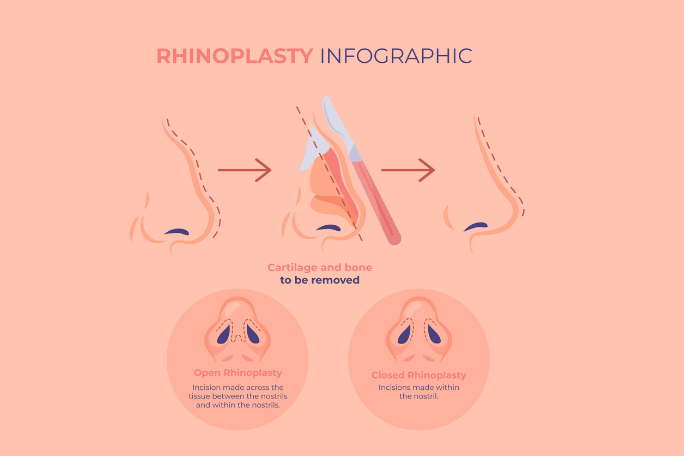Rhinoplasty

Feeling insecure about your nose or are you having problem in breathing due to your nose?
Rhinoplasty, commonly referred to as a “nose job,” is a cosmetic surgery operation used to change the nose’s size, shape, or structural make-up. This kind of surgery can be carried out for both curative and cosmetic purposes. Because of an injury, illness, or inherent problems, the nose may have a shape that needs to be corrected through rhinoplasty. Understanding rhinoplasty, its advantages, and any potential concerns is crucial if you’re thinking about having it done.
Who can get Rhinoplasty?
A person who is in good health and has reasonable expectations for the procedure’s results is the perfect candidate for rhinoplasty. You must be older than 18, the age at which nasal development is finished and in good mental and emotional health. Any person, regardless of age, who is considering rhinoplasty for medical purposes, such as resolving breathing problems brought on by a deviated septum, may be a good candidate.
Types of Rhinoplasty
- Structural rhinoplasty:
In order to repair, contour, and strengthen the nose where it is needed, structural rhinoplasty entails removing extra tissue and replacing tissue that is absent. There are few exceptions to the open rhinoplasty procedure that is typically used. In general, pen rhinoplasty provides better access and exposure for nasal tip surgery, whether or not cartilage grafting is used, in order to obtain the desired nose contour.
- Traditional rhinoplasty:
Traditional rhinoplasty, which is typically performed as a closed rhinoplasty, entails removing a significant amount of bone or cartilage from the nose. However, because this procedure may weaken the structure of your nose, there is a higher risk of an unfavourable result.
- Preservation Rhinoplasty:
The goal of preservation rhinoplasty is to keep the nose’s tissues and ligaments intact. In order to reshape the nose, your surgeon will release or remove tissue from other regions while preserving tissue on the nasal dorsum. In terms of outcomes, it is an option for patients who want to enhance their nose’s appearance while yet wishing to maintain its natural aesthetics.
- Functional rhinoplasty:
Functional rhinoplasty refers to the kind of rhinoplasty intended to maintain or improve the nose’s functionality, especially to assist the patient’s breathing. Functional rhinoplasty is most often recommended for those who have trouble breathing because of a severely clogged nose, a deviated septum, or any other issues that make it difficult for them to breathe normally.

How Does a Rhinoplasty Work?
There are two methods for rhinoplasty: open rhinoplasty and closed rhinoplasty. The columellate, the tissue band connecting the nostrils, will be cut in an open rhinoplasty by the surgeon. Smaller incisions must be made inside the nostrils for the closed rhinoplasty. Depending on the kind of surgical correction necessary, a particular form of incision is used. The first step in both treatments is anaesthesia, which will keep you asleep during the process.
Your surgeon may decide to use general anaesthesia or local anaesthesia combined with sedation depending on the complexity of the procedure and the degree of correction. The surgeon will manipulate the skin and cartilage to expose the nose’s bones after making the incision. The bone will then be moved into place once the surgeon has reshaped the cartilage. The nose bones will then receive another layer of tissues. Following the Surgery, you will need to wear a nasal splint after surgery to keep the newly formed components in place. To aid stop bleeding and swelling, packing materials may also be placed in each nostril.
Painkillers will be prescribed by your surgeon to help you deal with symptoms even though pain and discomfort are common. Following surgery, it is typical to experience bruising and swelling close to the nose and eyes. It may take several weeks for this swelling to go down, especially if you have more extensive surgery.
Benefits of Rhinoplasty
The physical alteration of the nose is the main advantage of rhinoplasty. This might raise the patient’s self-esteem and enhance their overall face attractiveness. Additionally, rhinoplasty can help with breathing problems and enhance general quality of life. Furthermore, rhinoplasty has a high rate of patient satisfaction and can produce results that last a lifetime. The advantages of rhinoplasty can be experienced by patients for many years following the procedure, making the cost justifiable.
A safe and efficient procedure called a rhinoplasty can help you get the appearance you want. It is essential to speak with a licensed and experienced surgeon if you have been considering rhinoplasty for either aesthetic or medical reasons, which are easily provided by our experts. They will aid in your comprehension of the surgery’s advantages and disadvantages as well as what to anticipate from the procedure. If rhinoplasty is right for you, the procedure can raise your self-confidence and enhance your general quality of life. The benefits of rhinoplasty can last for many years with the right care and upkeep, making it a great investment in your beauty and well-being.
Recovery Period
A successful operation requires a successful recovery. You must have a number of things and actions in mind. Here is a summary of the time-line for recovery:

